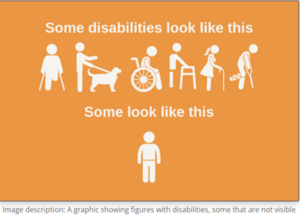
In recent years, my partner and I have taken our son away for his birthday instead of hosting a birthday party for him. We chose the destination together as a family, and this time, like the previous year, we all agreed to make the trek back to Chicago.
For most people, trips like this involve a flurry of last-minute packing and decision-making. For myself and my partner — both diagnosed with Attention Deficit/Hyperactivity Disorder (ADHD), social anxiety disorder and general anxiety disorder – packing for trips (including staycations) looks differently for us.
We both have what is known as invisible disabilities, which means they are not immediately apparent nor outwardly observable.
For example, we need extra time to complete tasks, detailed lists for what we are packing, timers, reminders and everything on the calendar. These items, plus taking medication and altering our diets, also support our cognitive and emotional functioning. Working memory and cognitive and auditory processing play a significant role in how we prepare for trips and how we enjoy them.
Finally, our trip date arrives. With everything impeccably organized, we board our flight smoothly and enjoy a quick Lyft ride to our hotel. We always book the first flights out as they’re typically less chaotic, but this means we often arrive at our hotels several hours before we’re allowed to check into our room.
I headed to the front desk to ask if we could leave our bags with the hotel while we explored the city and grabbed some food. The hotel person was lovely, smiled, and immediately rattled off several options we had and some additional information about the check-in process.
Remember, working memory plays a significant role in how I receive information, as does auditory processing. I apologized to her and explained that I’d been awake since 3 am to catch our flight, and I have ADHD and have not taken my medication, so I was struggling to process her recommendations. She smiled, took a breath, and rattled off the list again. I tried again using different wording: “I have a disability; my cognitive skills and auditory processing are not functioning well because of tiredness and lack of medication. Can you tell me the best option?” With that, she understood and gave me a succinct directive.
I nodded my head in understanding, repeated the directive back to her, and thanked her before heading back to my partner and our son.

This brief interaction is a snapshot of how living with invisible disabilities shapes our interactions and experiences. These very experiences also shape my approach to service as someone who supports a diverse spectrum of business travelers. The reality is that in many of our service interactions, invisible disabilities may not be revealed, so I prioritize making my service and information as inclusive and accessible to everyone. Here’s how:
- I keep information clearly outlined, concise, and digestible. With my invisible disability, my brain is easily overwhelmed by too much information — I just need to know the facts or the directive. Finer details can follow as needed.
- Use ensure communication is clear and simple. This reduces confusion about what is expected from a request, reduces stress and anxiety, and promotes a psychologically safe work environment. The recipient is not second-guessing themselves or you.
- I provide two strong options when problem-solving with my traveler. I never want my traveler to feel I am not flexible enough or that I provide too many options.
- I lean heavily on my manager when I need help with direct and customer-centric wording. She has been incredible in providing me with written templates I can copy and paste for specific scenarios. My manager also understands what and why I am asking for her support with templates. She does not view this as a weakness but commends me for asking for the support I need to deliver the best service.
As a result, I receive consistent positive feedback from travelers under my care.
Relocating isn’t easy, whether or not you’re living with an invisible disability. Here is the advice I’d offer to other travelers based on my own experiences as well as my experience in supporting mobile talent:
- Understand that people are still (un)learning thought processes that do not support or recognize invisible disabilities. Give them grace and patience as you share your needs.
- Advocate for yourself using the language you are most comfortable with. For example, “I’m sorry to ask you to repeat what you’ve explained again. I’ve been on a long flight and haven’t had my medication yet. Can you simplify my options for me?”
- Use your one-on-one time with your counselor to discuss what additional time or accommodation you need for the upcoming month. This is a great way to let them know how you’re doing and what additional support is needed to feel successful in your journey or job.
- Perfect your planning skills! Download helpful apps before traveling, like your phone’s wallet app — it stores everything from boarding passes to parking passes to membership passes — and create a fine-tuned schedule/process that supports your mental and emotional needs. When you’re organized, you’re better equipped to focus on each component of a journey.
- Set daily alarms that remind you to take specific types of breaks. Neurodivergent people need dopamine hits to decrease the desire to procrastinate, get off task, or spike their anxiety.
- Maintain an open dialogue with your manager/team using SMART goals. These parameters help ensure that personal and business objectives are attainable within a certain time frame. For example, “I want to have my weekly client report completed by 3 p.m. on Thursdays so that my manager has time to review the document and make any needed changes without either of us feeling pressed.”
Remember that invisible disabilities aren’t a weakness; they’re an intrinsic part of who we are, shaping our perspectives and fostering empathy. As service providers, they heighten our awareness of the diverse and unique needs of every customer we serve, empowering us to create more inclusive, understanding, and tailored solutions. Here’s to turning challenges into strengths that drive us to serve with compassion and purpose.
References:
The Unseen: Understanding Invisible Disabilities – Center for People With Disabilities. (2024, October 9). Center for People with Disabilities. https://cpwd.org/the-unseen-understanding-invisible-disabilities/